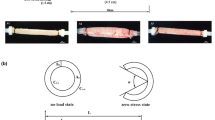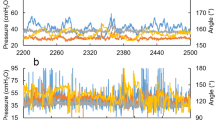Abstract
Methods based on cross-sectional ultrasound imaging may be valuable for assessment of biomechanical parameters in the duodenum in health and disease. In 12 healthy volunteers a specially designed duodenal bag containing a high-frequency ultrasound probe was inflated until the perception of moderate pain. The ultrasound images and bag pressures were recorded before and after administration of butylscopolamine. The duodenum approached a circular shape as the load was increased (P = 0.01). The tension-strain relations were exponential and the curve fitting constant α (stiffness) was 1.72±0.81 before and 1.13±0.22 after administration of butylscopolamine (P=0.5). In three subjects construction of stress-strain diagrams was possible. The wall thickness decreased after administration of butylscopolamine (P < 0.001). The wall thickness was nonhomogeneously distributed along the duodenal circumference, being thickest at high curvatures. In the future this may be useful for assessing the geometry, stiffness, remodeling, and mechanosensory properties in the duodenum and small intestine in health and disease.







Similar content being viewed by others
References
Feldman M, Friedman LS, Sleisenger MH (2002) Sleisenger & Fordtran’s Gastrointestinal and liver diseases, 7th ed. Saunders, New York
Grainger RG, Allison D, Dixon AK (2001) Grainger & Allison’s diagnostic radiology. Churchill Livingstone, New York
Gregersen H (2003) Biomechanics of the gastrointestinal tract. Springer-Verlag, London
Gregersen H, Kassab G (1996) Biomechanics of the gastrointestinal tract. Neurogastroenterol Motil 8(4):277–297
van der Schaar PJ, Lamers CB, Masclee AA (1999) The role of the barostat in human research and clinical practice. Scand J Gastroenterol Suppl 230:52–63
Ginzel KH (1960) Studies on the mechanism of the peristaltic reflex of the guinea pig ileum. Naunyn Schmiedebergs Arch Exp Pathol Pharmakol 238:104–1066
Barlow JD, Gregersen H, Thompson DG (2002) Identification of the biomechanical factors associated with the perception of distension in the human esophagus. Am J Physiol Gastrointest Liver Physiol 282(4):G683–G689
Gregersen H, Kraglund K, Djurhuus JC (1990) Variations in duodenal cross-sectional area during the interdigestive migrating motility complex. AmJ Physiol 259(1; Pt 1):G26–G31
Gregersen H, Orvar K, Christensen J (1992) Biomechanical properties of duodenal wall and duodenal tone during phase i and phase ii of the MMC. Am J Physiol 263(5; Pt 1):G795–G801
Gao C, Arendt-Nielsen L, Liu W, Petersen P, Drewes AM, Gregersen H (2003) Sensory and biomechanical responses to ramp-controlled distension of the human duodenum. Am J Physiol Gastrointest Liver Physiol 284(3):G461–G471
Sengupta JN, Gebhart GF (1994) Gastrointestinal afferent fibers and sensation. In: Johnson L (ed) Physiology of the gastrointestinal tract. Raven Press, New York, pp 483–519
Christensen J (1984) Origin of sensation in the esophagus. Am J Physiol 246(3; Pt 1):G221–G225
Jorgensen CS, Dall FH, Jensen SL, Gregersen H (1995) A new combined high-frequency ultrasound-impedance planimetry measuring system for the quantification of organ wall biomechanics in vivo. J Biomech 28(7):863–867
Assentoft JE, Gregersen H, O’Brien WDJr (2000) Determination of biomechanical properties in guinea pig esophagus by means of high frequency ultrasound and impedance planimetry. Dig Dis Sci 45(7):1260–1266
Nicosia MA, Brasseur JG, Liu JB, Miller LS (2001) Local longitudinal muscle shortening of the human esophagus from high-frequency ultrasonography. Am J Physiol Gastrointest Liver Physiol 281(4):G1022–G1033
Dai Q, Liu JB, Brasseur JG, Thangada VK, Thomas B, Parkman H, Miller LS (2003) Volume (3-dimensional) space-time reconstruction of esophageal peristaltic contraction by using simultaneous US and manometry. Gastrointest Endosc 58(6):913–919
Frøkjær JB, Andersen SD, Lundbye-Christensen S, Funch-Jensen P, Drewes AM, Gregersen H (2006) Sensation and distribution of stress and deformation in the human esophagus. Neurogastroenterol Motil 18(2):104--114
Gao C, Petersen P, Liu W, Arendt-Nielsen L, Drewes AM, Gregersen H (2002) Sensory-motor responses to volume-controlled duodenal distension. Neurogastroenterol Motil 14(4):365–374
Drewes AM, Gregersen H, Arendt-Nielsen L (2003) Experimental pain in gastroenterology: a reappraisal of human studies. Scand J Gastroenterol 38(11):1115–1130
Fung YC (1990) Biomechanics, motion, flow and growth. Springer Verlag, New York
Gregersen H, Christensen J (2000) Gastrointestinal tone. Neurogastroenterol Motil 12(6):501–508
Fan Y, Gregersen H, Kassab GS (2004) A two-layered mechanical model of the rat esophagus. Experiment and theory. Biomed Eng Online 3(1):40
Acknowledgments
The Danish Health Research Council (SSVF), the Research Council of North Jutland County, the Danish Diabetes Association, the Toyota Foundation, the Obel Foundation, and the SparNord Foundation are acknowledged for funding this project.
Author information
Authors and Affiliations
Corresponding author
Rights and permissions
About this article
Cite this article
Frøkjær, J.B., Andersen, S.D., Drewes, A.M. et al. Ultrasound-Determined Geometric and Biomechanical Properties of the Human Duodenum. Dig Dis Sci 51, 1662–1669 (2006). https://doi.org/10.1007/s10620-005-9015-y
Received:
Accepted:
Published:
Issue Date:
DOI: https://doi.org/10.1007/s10620-005-9015-y




